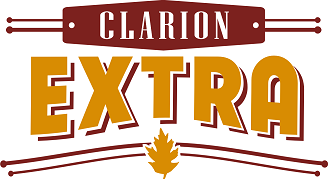By RANDY BARTLEY
CLARION — A walk through any cemetery will reveal a confusing variety of symbols carved into tombstones.
Largely replaced by more modern methods, these symbols were used for hundreds of years and into the early 20th century.
Anchor — This symbol is not often found in the Clarion County area but was use by early Christians as a disguised cross. An anchor with a broken chain stands for the cessation of life.
Angels — The agent of God, often is pointing towards heaven. Guardians of the dead, symbolizing spirituality, angels are shown in all types of poses with different symbolism and are identified by the objects they carry: Michael, who bears a sword and Gabriel, who is depicted with a horn.
Books — Books remind us that tombstones are documents, bearing vital statistics and epitaphs concerning the deceased. Books may be open, possibly to signify that the stone is a kind of biography, or closed in recognition of the fact that the story of the dead is over.
Butterfly — The soul. It is symbolic of the resurrection of Christ. The meaning is derived from the three stages of the life of the butterfly-the caterpillar, the chrysalis, and the butterfly. The three stages are symbols of life, death and resurrection.
Candle — Candles stand for the spirit or the soul. In Christian contexts, candles can symbolize Jesus Christ, the Light of the World.
Chains — Medieval thinkers sometimes held that a golden chain bound the soul to the body. Broken links on a headstone can mean the severance and subsequent release of the spirit from the body.
Chains are also the insignia of the International Order of Odd Fellows, so called because of their dedication to giving the poor decent burials
Chalice — The chalice often appears in association with a white circle representing the consecrated Eucharist.
The two items combine to signify the Catholic rite of Holy Communion. The headstones of priests often bear these objects.
Cross — Christianity. Usually mounted on three steps, signifying “faith, hope and charity.” The most potent symbol of the Christian faith, the cross has been used for religious and ornamental purposes since time immemorial.
Daisy — Innocence of child, Jesus the Infant, youth, the Son of righteousness, gentleness, purity of thought.
Dog — Modern dogs imply that the master was worth loving.
Dogwood — Christianity, divine sacrifice, triumph of eternal life, resurrection.
Dove — Catholics usually see the dove as the Holy Spirit. Jews interpret the dove as a peace symbol.
Draperies/Curtains –In the days when the body lay in state in the parlor, it was the custom to cover everything in black. They allow the expression of mourning to linger long. Curtains can also set the stage. Parted, they reveal a telling excerpt.
Heart — Stylized hearts stand for the affection of the living for the dead. Two joined hearts on a stone mark a marriage.
Holly — People used to believe that holly bushes protected tombs and other monuments from lightning strikes.
Ivy — Americans decided that it meant friendship and, like most cemetery plants, also immortality.
Lily — Chastity, innocence and purity. A favored funeral flower of the Victorians. The use of lilies at funerals symbolizes the restored innocence of the soul at death.
Lion — Symbolizes the power of God and guards the tomb against evil spirits
Oak tree — Hospitality, stability, strength, honor, eternity, endurance, and liberty. It is believed to have been the tree from which Jesus Christ’s cross was made. In smaller pioneer cemeteries, it is common to place children’s graves near oak trees.
Palm — Spiritual victory, success, eternal peace, and a symbol of Christ’s victory of death as associated with Easter.
Pine — Intimations of immortality ooze from the very sap of the pine tree. The cone, for example, ensures the perpetuity of life’s renewal.
Rose — Love, beauty, hope, and unfailing love, associated with the Virgin Mary.
Sacred Heart of Jesus — An image unique to Catholics. The Sacred Heart is shown containing wounds to which Christ points and it is surrounded by a crown of thorns. The heart represents the suffering of Jesus for our sins.
Scroll — A symbol of life and time. Both ends rolled up indicates a life that is unfolding like a scroll of uncertain length and the past and future hidden.
Star of David — Six-pointed star or Star of David, also known as Magen David (Hebrew for shield of David), it is typically used as a symbol of Judaism.
Torch — Lit, the torch signifies life — even eternal life. Extinguished, it stands for death. It can also stand for living memory and eternal life (e.g. an eternal flame).
Wheat — Tombstone carvers employ the ear of wheat as a symbol of rebirth.

